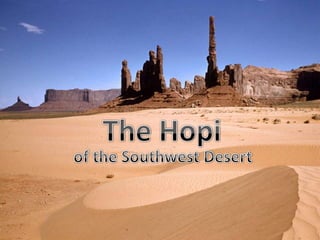
The Hopi
- 1. The Hopi of the Southwest Desert
- 2. Table of Contents The Southwest Desert……………………………………………………………………………….page 2 Hopi Homes………………………………………………………………………………………………page 3 Hopi Food………………………………………………………………………………………………….page 4 Hopi Clothes……………………………………………………………………………………………..page 5 Did You Know…………………………………………………………………………………………….page 6 Glossary……………………………………………………………………………………………………..page 7 1
- 3. The Southwest Desert In the southwest desert the land is flat except for occasionally flat topped mesas. Mesas are pieces of land several hundred feet above the desert floor. The sides of the mesas are steep and rocky. There are cactuses and animals that live near the mesas. Some of the animals are lynxes, cougars, antelopes and birds. It also does not rain a lot. There are some Native American tribes that live there, one is the Hopi. 2 Those are what mesas look like. This is my version of a mesa.
- 4. Hopi Homes Hopi homes are called pueblos. Pueblos are made of mud and stone. The oldest Hopi village is called Oraibi. It was started in 1050. It has been lived in continuously. Most Hopi villages live on three mesas. Some lived in the valleys below the mesas. Every pueblo has some underground chambers called kivas. Kivas are a place to gather to talk and to part in ancientceremonies. Pueblo means village in Spanish. The first pueblo only had one family living in them. Then villages became more frequent. So they built apartment like houses to protect them from attacks. These are pueblos. 3 This is what I mean about apartment like houses.
- 5. Hopi Food The Hopi grew lots of fruits and vegetables. The Hopi men would plant and harvest the crops. Some of crops were corn, beans, squash, peaches and apricots. They grew a lot of corn. The women would grind blue and white into cornmeal. They used cornmeal to make bread. These are some of the fruits and vegetables. 4 These are some corn they ate.
- 6. Hopi Clothes Hopi men wore very little clothing only breechcloths. Women wore short dresses called mantas. The dress fastened over the right shoulder and left the left shoulder bare. Men and women wore deerskin moccasins. The women painted the moccasins white and wrapped it around their legs on special occasions. Men wore cloth headbands around their foreheads. Their clothes were colorful. Some of the colors were green, blue and red. 5 This is a native American dress. That is a buffalo dancer.
- 8. The Hopi’s ancestors are called Anasazi.
- 9. Hopi means good, peaceful or wise.
- 10. Hopi chose to tend their crops rather then to go to war.
- 11. The Hopi lead the first white man to the Grand Canyon.
- 12. The Navajo killed many Hopi people in a war.6
- 13. Glossary Cactus: A plant with a thick trunk and spikes in place of leafs. Native: Someone born in a particular place. Occasionally: Happening from time to time. Harvest: The gathering of crops that are ripe. Grind: To crush something into powder. Cornmeal: Ground corn. Ceremonies: Formal actions, words, and often music performed to mark an important occasion. Frequency: If something happens frequency, it happens again and again. Ancient: very old. Breechcloths: A loin cloth Moccasins: A soft leather shoe or slipper without a heel Ancestors: Your ancestors are members of your family who lived a long time ago 7